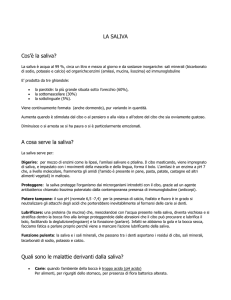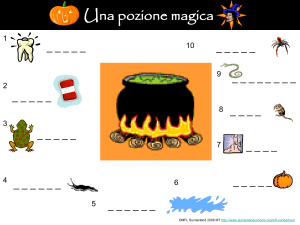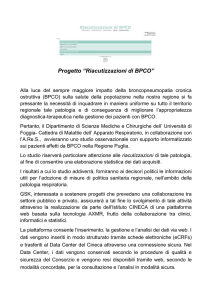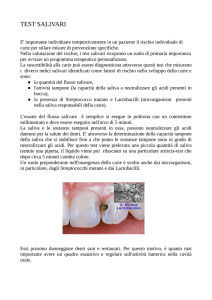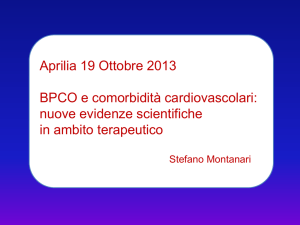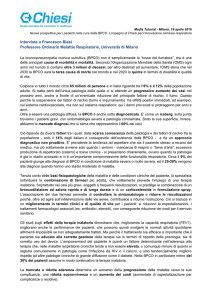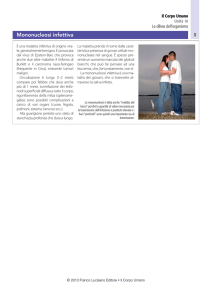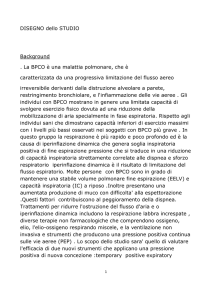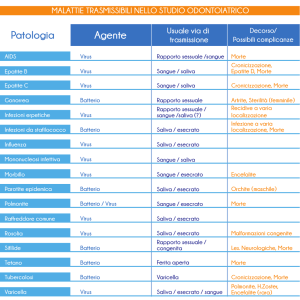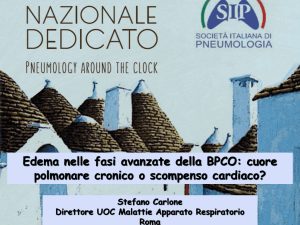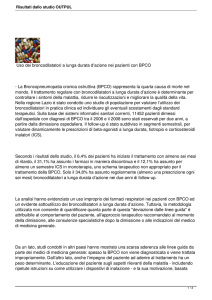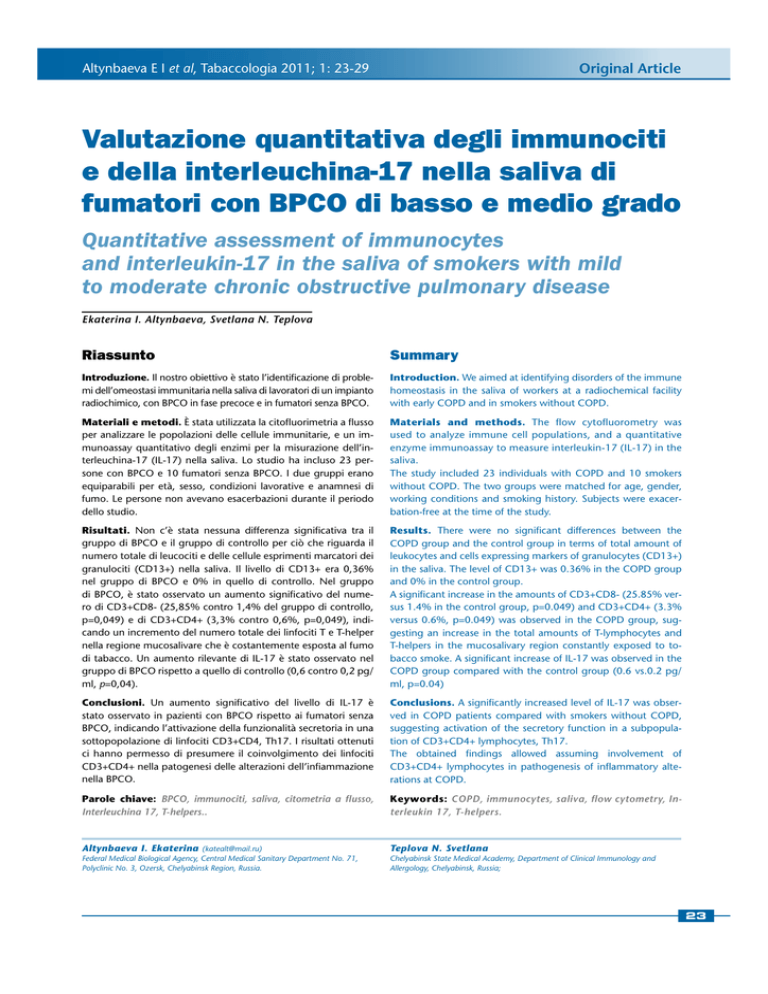
Original Article
Altynbaeva E I et al, Tabaccologia 2011; 1: 23-29
Valutazione quantitativa degli immunociti
e della interleuchina-17 nella saliva di
fumatori con BPCO di basso e medio grado
Quantitative assessment of immunocytes
and interleukin-17 in the saliva of smokers with mild
to moderate chronic obstructive pulmonary disease
Ekaterina I. Altynbaeva, Svetlana N. Teplova
Riassunto
Summary
Introduzione. Il nostro obiettivo è stato l’identificazione di problemi dell’omeostasi immunitaria nella saliva di lavoratori di un impianto
radiochimico, con BPCO in fase precoce e in fumatori senza BPCO.
Introduction. We aimed at identifying disorders of the immune
homeostasis in the saliva of workers at a radiochemical facility
with early COPD and in smokers without COPD.
Materiali e metodi. È stata utilizzata la citofluorimetria a flusso
per analizzare le popolazioni delle cellule immunitarie, e un immunoassay quantitativo degli enzimi per la misurazione dell’interleuchina-17 (IL-17) nella saliva. Lo studio ha incluso 23 persone con BPCO e 10 fumatori senza BPCO. I due gruppi erano
equiparabili per età, sesso, condizioni lavorative e anamnesi di
fumo. Le persone non avevano esacerbazioni durante il periodo
dello studio.
Materials and methods. The flow cytofluorometry was
used to analyze immune cell populations, and a quantitative
enzyme immunoassay to measure interleukin-17 (IL-17) in the
saliva.
The study included 23 individuals with COPD and 10 smokers
without COPD. The two groups were matched for age, gender,
working conditions and smoking history. Subjects were exacerbation-free at the time of the study.
Risultati. Non c’è stata nessuna differenza significativa tra il
gruppo di BPCO e il gruppo di controllo per ciò che riguarda il
numero totale di leucociti e delle cellule esprimenti marcatori dei
granulociti (CD13+) nella saliva. Il livello di CD13+ era 0,36%
nel gruppo di BPCO e 0% in quello di controllo. Nel gruppo
di BPCO, è stato osservato un aumento significativo del numero di CD3+CD8- (25,85% contro 1,4% del gruppo di controllo,
p=0,049) e di CD3+CD4+ (3,3% contro 0,6%, p=0,049), indicando un incremento del numero totale dei linfociti T e T-helper
nella regione mucosalivare che è costantemente esposta al fumo
di tabacco. Un aumento rilevante di IL-17 è stato osservato nel
gruppo di BPCO rispetto a quello di controllo (0,6 contro 0,2 pg/
ml, p=0,04).
Results. There were no significant differences between the
COPD group and the control group in terms of total amount of
leukocytes and cells expressing markers of granulocytes (CD13+)
in the saliva. The level of CD13+ was 0.36% in the COPD group
and 0% in the control group.
A significant increase in the amounts of CD3+CD8- (25.85% versus 1.4% in the control group, p=0.049) and CD3+CD4+ (3.3%
versus 0.6%, p=0.049) was observed in the COPD group, suggesting an increase in the total amounts of T-lymphocytes and
T-helpers in the mucosalivary region constantly exposed to tobacco smoke. A significant increase of IL-17 was observed in the
COPD group compared with the control group (0.6 vs.0.2 pg/
ml, p=0.04)
Conclusioni. Un aumento significativo del livello di IL-17 è
stato osservato in pazienti con BPCO rispetto ai fumatori senza
BPCO, indicando l’attivazione della funzionalità secretoria in una
sottopopolazione di linfociti CD3+CD4, Th17. I risultati ottenuti
ci hanno permesso di presumere il coinvolgimento dei linfociti
CD3+CD4+ nella patogenesi delle alterazioni dell’infiammazione
nella BPCO.
Conclusions. A significantly increased level of IL-17 was observed in COPD patients compared with smokers without COPD,
suggesting activation of the secretory function in a subpopulation of CD3+CD4+ lymphocytes, Th17.
The obtained findings allowed assuming involvement of
CD3+CD4+ lymphocytes in pathogenesis of inflammatory alterations at COPD.
Parole chiave: BPCO, immunociti, saliva, citometria a flusso,
Interleuchina 17, T-helpers..
Keywords: COPD, immunocytes, saliva, flow cytometry, Interleukin 17, T-helpers.
Altynbaeva I. Ekaterina ([email protected])
Federal Medical Biological Agency, Central Medical Sanitary Department No. 71,
Polyclinic No. 3, Ozersk, Chelyabinsk Region, Russia.
Teplova N. Svetlana
Chelyabinsk State Medical Academy, Department of Clinical Immunology and
Allergology, Chelyabinsk, Russia;
23
Original Article
Introduzione
Altynbaeva E I et al, Tabaccologia 2011; 1: 23-29
Introduction
Le membrane mucose che coprono il tratto
Mucous membranes lining the upper rerespiratorio superiore sono il punto di enspiratory tract are the entrance and colonitrata e colonizzazione per vari agenti microzation site for various microbial agents [1]
[1].
biologiche [1]. Le membrane mucose hanno
Mucous membranes play a leading role in
un ruolo fondamentale nella risposta antithe antimicrobial response, which depends
microbica, che dipende sulla natura dell’anon the nature of antigen and the potential
tigene e sul potenziale effetto di agenti di
effect of biologically aggressive environaggressività biologica [2]. La dipendenza dal
mental agents [2]
[2]. Tobacco dependence
tabacco danneggia significativamente la disignificantly impairs the antibacterial deAltynbaeva I. Ekaterina
fesa antibatterica delle membrane mucose,
fense of mucous membranes, resulting in
risultando in una violazione della barriera
a breach of the anti-microbial physical barfisica ed in una diminuita migrazione e funzione secretiva
rier and decreased migration and secretory function of
da parte delle cellule fagocitarie. Questo può facilitare la
phagocytosing cells. This can facilitate the persistence of
persistenza di agenti estranei e l’accumulo di fattori proforeign agents and the accumulation of endogenous proinfiammatori endogeni di natura immunitaria [3,4].
inflammatory factors of immune origin [3,4]
[3,4].
Le tecniche di laboratorio attuali permettono un’analisi
Current laboratory techniques allow a precise analysis
precisa delle proteine immunitarie prodotte a livello del
of immune proteins produced at the level of mucosa-astessuto linfoide associato alla mucosa (MALT) nel tratto
sociated lymphoid tissue (MALT) in the respiratory tract
respiratorio e nella saliva, sia in condizioni normali sia
and in the saliva, both under the normal condition and
in presenza di patologia. La citofluorimetria a flusso può
developed pathology. Flow cytofluorometry can be used
essere utilizzata per analizzare la composizione cellulare
to analyze the cellular composition of secretory products
dei prodotti della secrezione [5]. L’analisi dei fattori im[5]. The analysis of immune factors in the is a non-inva[5]
munitari è un metodo non invasivo per la valutazione
sive method to assess the effect of tobacco smoke on the
dell’effetto del fumo di tabacco sulle membrane mucose
mucous membranes and mucosal immunity system in the
e sul sistema immunitario delle mucose della cavità orale,
oral cavity, possibly reflecting the effects on the bronchoprobabilmente riflettendo gli effetti sul sistema broncopulmonary system.
polmonare.
IL-17 is produced by Th17 T cells. Effector molecules
L’IL-17 è prodotta da cellule Th17. Molecole effettrici
produced by these cells include IL-17A, IL-17F, IL-22 and
prodotte da queste cellule comprendono IL-17A, IL-17F,
IL-26. IL-17 was discovered in 1993, and its receptor was
IL-22 e IL-26. L’IL-17 è stata scoperta nel 1993 e il suo reidentified in 1995 [9]
[9]. IL-17 plays a role in granulocytocettore nel 1995 [9]. L’IL-17 svolge un ruole nella granulopoiesis and protection against extra-cellular pathogens.
citopoiesi e nella protezione contro patogeni extracellulaIL-17F and IL-22 regulate production of antimicrobial prori. Le IL-17F e IL-22 regolano la produzione di proteine ad
teins in mucous epithelium.
attività antimicrobica nell’epitelio delle mucose. L’IL-17A
IL-17A stimulates epithelial cells in bronchi, venous enstimola le cellule epiteliali nei bronchi, le cellule endotedothelial cells and stimulates the production and release
liali venose e stimola la produzione e il rilascio dell’IL-8, la
of IL-8, which is chemoattractive for neutrophils [9]
[9]. In
quale è chemioattrattiva per i neutrofili [9]. Inoltre, l’IL-17
addition, IL-17 regulates the expression of specific chemoregola l’espressione di specifici ligandi per le chemochine
kine ligands CXCR1 and CXCR2, in the fibroblasts and
CXCR1 e CXCR2, nei fibroblasti e nelle cellule epiteliali.
epithelial cells. CXCR1 and CXCR2 promote the migraLe CXCR1 e CXCR2 promuovono la migrazione dei leucotion of leukocytes into the MALT. In vitro, IL-17 injected
citi nel MALT. In vitro, iniezioni di IL-17 nel fluido sinoin the synovial fluid accelerated the accumulation of neuviale hanno accelerato l’accumulo di neutrofili.
trophils.
Supponiamo che l’elevato livello di IL-17 nella saliva di
We hypothesize that the increased level of IL-17 in safumatori con forme iniziali di broncopneumopatia croniliva from smokers with early forms of chronic obstructive
ca ostruttiva (BPCO) possa essere un marker di gravità per
pulmonary disease (COPD) could be a marker of severity
l’accertamento del processo infiammatorio nella fase inifor the assessment of inflammatory process at the early
ziale della malattia.
phase of disease.
Lo scopo di questo studio era di identificare i disturbi
The aim of this study was to identify disorders of imdell’omeostasi immunitaria nella zona mucosalivare utimune homeostasis in mucosalivary region by using the
lizzando l’analisi citofluorometrica di popolazioni di cellucytofluorometric analysis of immune cell populations and
le immunitarie e l’immunoassay enzimatico quantitativo
the quantitative enzyme immunoassay of interleukin-17
dell’interleuchina-17 (IL-17). Sono stati studiati campioni
(IL-17). Saliva samples of employees of a radiochemical fadi saliva dei lavoratori di un impianto radiochimico, fucility, smokers and with early chronic obstructive pulmomatori e con fase precoce di broncopneumopatia cronica
nary disease (COPD), free from acute exacerbations were
ostruttiva, senza esacerbazioni acute.
studied.
24
Original Article
Altynbaeva E I et al, Tabaccologia 2011; 1: 23-29
Materiali e metodi
Materials and methods
Questo studio fa parte di un progetto di ricerca sul ruolo
dell’immunopatologia nella patogenesi della BPCO, condotta nel Dipartimento Sanitario Centrale n.71 (Ozyorsk,
Russia) e nel Dipartimento di Immunologia Clinica ed Allergologia della Chelyabinsk State Medical Academy (Chelyabinsk, Russia). Negli ultimi 15 anni, è stato condotto un
programma di monitoraggio spirometrico e dei parametri
immunologici clinici di pazienti con BPCO che lavorano
in un impianto radiochimico. La maggior parte dei lavoratori dell’impianto radiochimico sono fumatori, e quindi
a rischio di sviluppo di BPCO. Lo studio è stato eseguito
come parte di esami medici regolari all’Unità specializzata di Prevenzione del Policlinico / Dipartimento Sanitario
Centrale n.71 dell’Agenzia Federale Medico-biologica (FMBA) della Russia.
Nel gruppo BPCO sono stati reclutati ventitré soggetti
con lieve a moderata BPCO e in quello di controllo sono
state incluse dieci persone senza BPCO. Tutti i soggetti erano fumatori e lavoratori nell’impianto radiochimico. Nei
due gruppi c’era una corrispondenza di età, sesso, condizioni lavorative, indice di fumo e anamnesi. Entrambi i
gruppi sono stati sotto costante follow-up per gli ultimi
dieci anni. Le caratteristiche dei pazienti sono presentante
nella Tabella 1. La BPCO è stata diagnosticata secondo i
standard diagnostici GOLD (2003, 2006) [6,7], il Programma Federale titolato “Broncopneumopatia Cronica Ostruttiva” (2004) e gli Standards per la Diagnosi ed il Trattamento della BPCO (2005). I criteri diagnostici per la BPCO
includono l’anamnesi farmacologica; la presenza di sintomi cronici (tosse, produzione di espettorato, dispnea); i
dati fisici (auscultazione del torace) e i test della funzionalità polmonare (PFT) (FEV1/FVC <70%). I PFT comprendono inoltre un test di broncodilatazione (aumento di FEV1
<12% o <200 mL rispetto al valore di base baseline dopo
inalazione di salbutamolo 400 g). La BPCO è stata suddivisa secondo i valori della FEV1: >80% (stadio I, lieve),
50%< FEV1 <80% (stadio II, moderato).
La raccolta della saliva è stata fatta di mattina, a stomaco vuoto, dieci minuti dopo la risciacquatura della
cavità orale con acqua, in flaconi di vetro asciutti senza
This study is a part of a research project on the role of immunopathology in the pathogenesis of COPD, conducted
at the Central Medical Sanitary Department n. 71 (Ozyorsk, Russia) and Department of Clinical Immunology and
Allergology of Chelyabinsk State Medical Academy (Chelyabinsk, Russia).
During the last 15 years, a program of monitoring the
spirometric and clinical immunological parameters of
COPD patients working at the radiochemical facility has
been conducted. Most workers of the radiochemical facility are smokers, therefore at risk of developing COPD.
The study was performed as a part of regular medical examinations at the specialized Prevention Unit of the Industrial Polyclinic/Central Medical Sanitary Department
n.71 of the Federal Medical Biological Agency (FMBA) of
Russia.
Twenty-three subjects with mild to moderate COPD
were included in the COPD group, and 10 subjects without COPD were included in the control group All subjects
were smokers and employed at the radiochemical facility.
The two groups were matched by age, gender, working
conditions, smoking index and history. Both groups were
under constant follow-up for the last ten years. Patients’
characteristics are shown in Table 1.
COPD was diagnosed in accordance with the GOLD
Diagnosing Standards (2003, 2006) [6,7]
[6,7], the Federal Program titled “Chronic Obstructive Pulmonary Disease”
(2004), and the COPD Diagnosing and Treatment Standards (2005).
Diagnosis criteria for COPD included past medical history; presence of chronic symptoms (cough, sputum production, dyspnea); physical data (chest auscultation) and
pulmonary function tests (PFTs)(FEV1/FVC ratio <70%).
PFTs also included a bronchodilation test (increase of FEV1
<12% or <200 mL compared to the baseline value after
inhalation of salbutamol 400 mg). COPD was staged according to FEV1 values: >80% (stage I, mild), 50%< FEV1
<80% (stage II, moderate).
Saliva collection was performed in the morning, with
empty stomach, 10 min after rinsing the oral cavity with
Tabella 1. Caratteristiche del paziente.
Gruppo BPCO
(n = 23)
Gruppo di controllo
(n = 10)
Valore p
49,67 ± 1,14
48,58 ± 2,67
0,330
Pachetti-anni
40 ± 13
n/d
n/d
Indice Fumo
199,66 ± 8,01
n/d
n/d
FEV1 (% pred)*
65,1 ± 1,8
84,4 ± 1,1
0,00001
FEV1/FVC
69,1 ± 1,2
95,5 ± 2,1
0,00001
Caratteristiche
Età (anni)
* dopo broncodilatatore
25
Original Article
Altynbaeva E I et al, Tabaccologia 2011; 1: 23-29
water, in dry glass flasks without
stimolazione
dell’escrezione
Bronco normale in non fumatore
stimulation of salivary discharge.
salivare. I campioni di saliva
Saliva specimens were analyzed
sono stati analizzati entro le
within 2 hrs after collection at the
due ore successive la raccolta
maintained at 40C. Saliva specia temperatura di 4oC. I cammens were prepared and cellular
pioni sono stati preparati ed è
composition of immunocytes in
stata analizzata la composiziosaliva was analyzed using a flow
ne cellulare degli immunociti
cytofluorometer, BD FACSCanto II
presenti nella saliva utilizzan(Becton Dickinson, USA), in acdo un citofluorometro a fluscordance with the certified proso BD FACSCanto II (Becton
cedure, Patent No. 2008120724
Dickinson, USA), secondo le
as of 23.05.08 (Teplova S.N., Koprocedure certificate, Patenta
chengina S.A., et al.).
No. 2008120724 as of 23.05.08
The procedure of samples prep(Teplova S.N., Kochengina S.A.,
aration was based on the rinse
et al.). La procedura della pretechnology with RPMI and bicarparazione dei campione è stata
bonate. The population compobasata sulla tecnologia del risition of immune cells in saliva
sciacquo on con RPMI e bicarwas analyzed using the monobonato. La composizione delle
clonal antibody-based kits (MAK)
cellule immunitarie nella saliva
labeled with four fluorescent
è stata analizzata utilizzando i
dyes, Fluorescein Isothiocyanate
kit basati su anticorpi monoBPCO in fumatore
(FITC), Phycoerythrin (PE), Periclonali (MAK) caratterizzati da
din-Chlorophyll Protein (PerCP),
quattro coloranti fluorescenti,
Allophycocyanin (APC) from the MultiTest series (manla Fluoresceina isotiocianato (FITC), la Ficoeritrina (PE),
ufactured by Becton Dickinson, USA), and a vital dye,
la Proteina Peridina-Clorofilla (PerCP), l’Alloficocianina
7-AAD.
(APC) dai MultiTest (fabbricati da Beston Dickinson, USA)
The cytofluorometric analysis of the cellular composie un colorante vitale, il 7-AAD. L’analisi citofluorometrica
tion of saliva accounted for at least 10,000 events. The
della composizione cellulare della saliva ha individuato
number of viable cells expressing a leukocyte common
almeno 10,000 eventi. Il numero delle cellule vitali che
antigen, CD45+, was accounted for using 7-AAD, includesprimevano un antigene leucocitario comune, CD45+,
ing populations of immunocytes such as granulocytes
incluse le popolazioni di immunociti come i granulociti
(CD45+CD13+CD14-), monocytes (CD45+CD14+CD13–),
(CD45+CD13+CD14-), i monociti (CD45+CD14+CD13–),
T-cytotoxic lymphocytes (CD45+CD3+CD8+), T-helpers
i linfociti T citotossici (CD45+CD3+CD8+), i T-helpers
(CD45+CD3+CD4+), NK-cells (CD45+CD56+16+).
(CD45+CD3+CD4+), le cellule NK (CD45+CD56+16+), è
Cells were separated based on the expression of a differstato rilevato usando il 7-AAD. Le cellule sono state dientiation marker, CD45. CD45+/CD45- ratio of cells and
stinte in base all’espressione di un marker di differenziacell pellets in saliva is illustrated in Figure 1. The gate of
zione, il CD45. Il rapporto CD45+/CD45- delle cellule e
viable cells with a linear differentiation marker, CD45+, is
dei pellet cellulari presenti nella saliva sono illustrati nella
shown on Figure 2.
Figura 1. Le cellule vitali con un marker di differenziaLevels of IL-17 in saliva were measured using enzyme
zione lineare, CD45+, è mostrato nella Figura 2. I livelli
immunoassay with a test-system, Human IL-17A ELISA
di IL-17 nella saliva sono stati misurati utilizzando l’imBMS2017 and BMS2017TEN (Bender MedSystems, Vienmunoassay enzimatico con un sistema di test, il Human
na, Austria), for analyses of biological fluids, with a plate
IL-17A ELISA BMS2017 e BMS2017TEN (Bender MedSyphotometer, Multiscan plus (Labsystems, Finland), 450
stems, Vienna, Austria), per le analisi dei fluidi biologici,
nm. The test-system sensitivity was 1 pg/mL. The levels
con un fotometro, Multiscan plus (Labsystems, Finlanda),
of IL-17 produced by a relatively new line of T-cells, Th17,
450 nm. La sensitività del test-system era di 1 pg/mL. Sono
related to CD+ lymphocytes, were measured in saliva [8]
stati misurati nella saliva i livelli di IL-17 prodotta da una
[8].
relativamente nuova linea di cellule T, Th17, correlati ai
The study was approved by the Ethical Committee of
linfociti CD+ [8]. Lo studio è stato approvato dalla comthe Central Medical Sanitary Department No. 71 of the
misione etica del Dipartimento Sanitario Centrale No.71
FMBA Russia.
dell’FMBA Russia. Il consenso informato è stato ottenuto
The informed consent was obtained from each particida ogni partecipante e lo studio è stato eseguito secondo
pant, and the study was performed in accordance with the
la Dichiarazione di Helsinki sui Principi Etici per la Ricerca
Declaration of Helsinki on Ethical Principles for Medical
Medica che Coinvolge Soggetti Umani.
Research Involving Human Subjects.
26
Original Article
Altynbaeva E I et al, Tabaccologia 2011; 1: 23-29
L’analisi statistica è stata condotta con il programma
Statistics, Versione 6. I risultati vengono presentati nelle
tabelle come mediane e i suoi range interquartili. Le comparazioni tra i gruppi sono state eseguite attraverso il test
Mann-Whitney. Valori di p <0,05 sono considerati significanti.
Statistical analysis was performed using Statistics, Version 6. The obtained results are given in the tables as
the median and its quartile range. The inter-group comparisons were performed by Mann-Whitney test. p values
<0.05 were regarded as significant.
Risultati
I risultati dell’analisi citofluorometrica della popolazione delle cellule immunitarie nella saliva si trovano nella
Tabella 2. Non ci sono state differenze significative tra il
numero relativo e assoluto di cellule vitali nella saliva degli individui dei due gruppi (25% del gruppo BPCO contro 18% del gruppo di controllo). Vari tipi di anticorpi
monoclonali e traccianti fluorescenti sono stati utilizzati per misurare la quantità di specifiche popolazioni vitali di immunociti in campioni di saliva. Come
è mostrato nella Tabella 2, i granulociti con fenotipo
(CD45+CD13+CD14-) rappresentavano l’89-95% di leucociti vitali in entrambi i gruppi. Sono stati osservati
meno macrofagi (5,6% nel gruppo BPCO e 1,15% in
quello di controllo) e linfociti (5,7% nel gruppo BPCO
e 0,9% in quello di controllo) nei campioni di saliva.
Non ci sono state differenze tra i due gruppi per quanto riguarda il numero relativo ed assoluto di granulociti
(CD13+CD14-), macrofagi (CD14+CD13+), natural killers
(singolo- e doppio-positivo CD16+ e CD56+), e linfociti B
(CD19+). È stato trovato un aumento significativo di linfociti CD3+CD4+ nel gruppo BPCO in confronto al gruppo
di controllo, (3,3% contro 0,6%, p=0,049), il quale ha mostrato un incremento significativo dei linfociti T-helper,
senza alterazione del numero totale di cellule citotossiche
nella regione mucosalivare. I livelli di IL-17 prodotti da
The findings of cytofluorometric analysis of the population of immune cells in saliva are given in Table 2. There
were no significant differences between the relative and
absolute amounts of viable cells in the saliva of individuals from the two groups (25% in the COPD group vs.
18% in the control group). Several types of monoclonal
antibodies and fluorescent labels were used to measure
the amount of specific viable populations of immunocytes
in saliva samples As shown in Table 2, granulocytes with
phenotype (CD45+CD13+CD14-) represented 88-95%
of viable leukocytes in both groups. Fewer macrophages
(5.6% in the COPD group and 1.15% in the control group)
and lymphocytes (5.7% in the COPD group and 0.9% in
the control group) were observed in the saliva samples.
There were no differences between the two groups in
terms of relative and absolute amounts of granulocytes
(CD13+CD14-), macrophages (CD14+CD13+), natural
killers (single- and double-positive CD16+ and CD56+),
and B-lymphocytes (CD19+). A significant increase in the
CD3+CD4+ lymphocytes (3.3% vs. 0.6%, p = 0.049) was
found in the COPD group in comparison with the control
group, which indicated a significant increase of T-helpers
lymphocytes, without alteration of the total amount of
cytotoxic cells in the mucosalivary region. IL-17 levels
produced by a relatively new line of T-cells, Th17, related
to the CD4+ lymphocytes, were measured in saliva. A sig-
Fig. 1. Distribuzione delle cellule nella saliva sotto analisi citofluorometrica.
Fig. 2. Gate delle cellule vitali CD45+ nella saliva.
Results
27
Original Article
Altynbaeva E I et al, Tabaccologia 2011; 1: 23-29
una relativamente nuova linea di cellule T, la Th17, correlata ai linfociti CD4+, sono stati misurati nella saliva.
Un significativamente elevato livello di IL-17, secreta dai
T-helper 17 è stato trovato nel gruppo BPCO in confronto
al gruppo di controllo. È stata analizzata la relazione tra
la quantità di immunociti e livelli di IL-17 nella saliva. È
stata trovata una correlazione notevolmente positiva tra
i livelli di IL-17 e il numero dei T-helper, in entrambe le
espressioni, percentuale ed assoluta (r = 0,45, p = 0,001),
suggerendo un ruolo primario delle cellule CD4+ nella
produzione di interleuchine nei fumatori.
Discussione
L’analisi citofluorometrica dello spettro della popolazione di immunociti nei campioni di saliva, hanno rivelato
che il gruppo di leucociti vitali è stato piuttosto piccolo,
circa il 20-25% del numero totale delle cellule, con una
quantità grande di pellet cellular, in fumatori con e senza
BPCO. I granulociti sono stati la popolazione prevalente
tra le cellule vitali, rappresentando l’88-95% degli immunociti totali presenti nella saliva. Tuttavia, i linfociti
T-helper (CD45+CD3+CD4+) sono stati più numerosi negli individui con BPCO lieve a moderata in confronto ai
fumatori senza BPCO. È stato inoltre trovato un aumento
di IL-17 nella saliva di lavoratori con BPCO in confronto al gruppo di controllo. I livelli di IL-17 in correlazione con il numero totale delle cellule CD4+ nella saliva,
nificantly increased level of IL-17 secreted by T-helpers 17
was found in the COPD group compared with the control
group. The relationship between the amounts of immunocytes and the levels of IL-17 in the saliva was analyzed.
A significantly positive correlation between levels of IL-17
and amounts of T-helpers, both in the percentage and absolute expression, was found (r = 0.45, p = 0.001), suggesting a leading role of the CD4+ cells in production of the
interleukins in smokers.
Discussion
The cytofluorometric analysis of the population spectrum
of immunocytes in saliva samples revealed that the pool
of viable leukocytes was rather small, about 20-25% of the
total number of cells, with a large amount of cell pellet, in
smokers with and without COPD. Granulocytes were the
prevalent population among viable cells, representing 8895% of total immunocytes in the saliva.
However, T-helper lymphocytes (CD45+CD3+CD4+) were
more numerous in individuals with mild to moderate
COPD in comparison with smokers without COPD. An
increase of IL-17 in the saliva of workers with COPD, compared with the control group, was also found. IL-17 levels correlated with the total amount of CD4+ cells in the
saliva, suggesting an activation of the secretory function
by a subpopulation of the CD3+CD4+ lymphocytes, especially T-helpers 17. The two groups of subjects, with and
Tabella 2. Sottopopolazioni di immunociti presenti nella saliva nel gruppo BPCO e nel gruppo di controllo.
Gruppo BPCO
n = 23
Fattore
28
Gruppo di controllo
n = 10
Valore p
Mediana
Q25-Q75
Media±dev.st.
Mediana
Q25-Q75
Media±dev.
st.
Leucociti (abs*106)
2,40
1,75-2,90
2,42±0,72
2,43
2,20-2,65
2,43±0,32
0,944
Cellule vitali
(L-vital) (%)
25,20
18,70-41,60
28,92±16,75
18,85
7,40-30,30
18,85±16,19
0,482
CD45+CD13+14- (%)
88,80
39,25-95,50
68,80±35,96
95,35
93,70-97,00
95,35±2,33
0,261
CD45+CD14+13- (%)
0,00
0,00-0,02
0,10±0,22
0,00
0,00-0,00
0,00±0,00
0,440
CD45+CD 13+14+ (%)
5,60
2,00-58,25
26,78± 36,82
1,15
1,00-1,30
1,15 (0,21)
0,160
CD45+CD3+ (%)
2,25
0,35-5,00
8,61±20,16
0,20
0,10-0,30
0,20 (0,14)
0,205
CD45+CD3+CD4+ (%)
3,30
2,20-10,15
13,84±24,77
0,60
0,00-1,20
0,60 (0,85)
0,049
CD45+CD3+8- (%)
25,85
6,00-81,85
38,11± 37,69
1,40
1,10-1,70
1,40 (0,42)
0,049
CD45+CD3+8+ (%)
0,20
0,05-0,75
0,74±1,18
0,15
0,00-0,30
0,15±0,21
0,617
CD45+CD19+ (%)
3,35
1,10-6,85
7,04±12,18
0,70
0,30-1,10
0,70±0,57
0,182
CD45+CD16+56- (%)
0,75
0,15-1,85
1,59±2,44
0,00
0,00-0,00
0,00±0,00
0,106
CD45+CD56+16- (%)
44,15
17,75-74,90
46,59± 30,10
31,90
0,60-63,20
31,90±44,26
0,433
CD45+CD56+16+ (%)
5,20
1,45-21,20
11,65±14,79
29,80
0,90-58,70
29,80±40,87
0,602
Original Article
Altynbaeva E I et al, Tabaccologia 2011; 1: 23-29
indica un’attivazione della funzione secretoria da parte
di una sottopopolazione dei linfociti CD3+CD4+, specialmente dai T-helper 17. I due gruppi di soggetti, con
e senza BPCO in fase precoce, corrispondevano per sesso,
età, anamnesi di fumo ed erano impiegati nello stesso impianto radiochimico. Tutti gli individui non hanno avuto
esacerbazioni nella durata dello studio. L’elevata quantità
di cellule CD4+ e livelli di IL-17 nella saliva di soggetti con
BPCO può rispecchiare una attivazione del sistema immunitario a livello del MALT della regione mucosalivare, la
quale costituisce il sito di entrata per patogeni, antigeni ed
allergeni. La regione mucosalivare come parte del sistema
di protezione delle membrane mucosali, potrebbe inoltre
indicare alterazioni simili nel tratto respiratorio superiore
ed in particolare, nel tessuto linfatico associato ai bronchi
(BALT). Questo fatto, però, deve essere confermato da studi specifici.
Conclusione
Lo studio ha mostrato una specificità della composizione
cellulare degli immunociti presenti nella saliva di fumatori
con BPCO che lieve a moderata che è stata vista nella prevalenza della popolazione dei T-helper, con un rapporto
alto di CD4+/CD8+. È stato inoltre misurato nello stesso
gruppo, un elevato livello di IL-17 nella saliva, in confronto al gruppo di controllo di fumatori senza BPCO. !
without early COPD, were matched for gender, age, smoking history and were employed in the same radiochemical
facility. All subjects were exacerbation-free at the time of
the study.The increased amounts of CD4+ cells and IL-17
levels in the saliva of subjects with COPD may reflect an
activation of the immune system in MALT of the mucosalivary region, which is the entrance site for pathogens,
antigens and allergens. As part of protection system of
mucous membranes, the mucosalivary region may also reflect similar alterations in the upper respiratory tract and,
in particular, in the bronchus-associated lymphoid tissue
(BALT). This, however, remains to be confirmed with specific studies.
Conclusion
The study indicated that a specificity of the cellular composition of immunocytes in the saliva of smokers with
mild to moderate COPD was in the prevalence of T-helper
population, with a correspondingly high ratio of CD4+/
C8+. A high level of IL-17 in saliva was also measured in
this group in comparison with the control group of smokers without COPD. !
Disclosure: L’Autore dichiara l’assenza di qualsiasi tipo di
conflitto di interesse.
Traduzione: Charilaos Lygidakis
BIBLIOGRAFIA
1. Teplova SN, Alexeev DA Secretory immunity. Chelyabinsk 2002: 143-155 [ Russian].
2. Ignatova GL, Immune status in patients
with chronic bronchitis. In: Factors of Cellular and Humoral Immunity in Various Pathological and Physiological Conditions. The
Book of Abstracts of the Republican Research
Conference. Chelyabinsk 1992: 42 [Russian].
3. Schwarzman JS, Hazenson LB Local immunity. Moscow 1978: 224 [Russian].
4. Simbirtsev AS, Cytokines: classification
and biological functions. Cytokines and In-
flammation 2004; 3(2): 16-23 [Russian].
5. Haydukova SV, Zurochki SV, Issues of the
Modern Flow Cytometry. Clinical Application. Chelyabinsk 2008: 195 [Russian].
6. Global Initiative for Chronic Obstructive
Lung Disease. Global Strategy for the Diagnosis, Management, and Prevention of
Chronic Obstructive Pulmonary Disease. Executive summary. Bethesda, National Heart,
Lung and Blood Institute 2003; www.goldcopd.com.
7. Global Initiative for Chronic Obstruc-
tive Lung Disease. Global Strategy for the
Diagnosis, Management, and Prevention
of Chronic Obstructive Pulmonary Disease.
Executive Summary 2006. Medical Communications Resources, Inc., 2006:1-32.
8. Ley K, Smith E, Stark MA, IL-17A-producing neutrophil-regulatory Th-lymphocytes.
Immunol Res 2006; 34(3): 229-242.
9. Aujla SJ, Dubin PJ, Kolls JK, Th17 cells
and mucosal host defense. Semin Immunol
2007; 19: 362-371.
29

